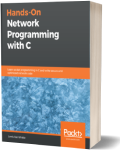Hands-On Network Programming with C
Networking
Book Details
Book Title
Hands-On Network Programming with C
Author
Van Winkle, Lewis
Publisher
Packt
Publication Date
2019;2020
ISBN
9781789349863
Number of Pages
467
Language
English
Format
File Size
5.3MB
Subject
low-level-networking
Table of Contents
- Network Programming in C
- Cover
- Title Page
- Copyright and Credits
- Dedication
- About Packt
- Contributors
- Table of Contents
- Preface
- Section 1 - Getting Started with Network Programming
- Chapter 1: Introducing Networks and Protocols
- Technical requirements
- The internet and C
- OSI layer model
- TCP/IP layer model
- Data encapsulation
- Internet Protocol
- Domain names
- Internet routing
- Port numbers
- Clients and servers
- Putting it together
- What's your address?
- Listing network adapters from C
- Summary
- Questions
- Chapter 2: Getting to Grips with Socket APIs
- Technical requirements
- What are sockets?
- Socket setup
- Two types of sockets
- Socket functions
- Anatomy of a socket program
- Berkeley sockets versus Winsock sockets
- Our first program
- Summary
- Questions
- Chapter 3: An In-Depth Overview of TCP Connections
- Technical requirements
- Multiplexing TCP connections
- Synchronous multiplexing with select()
- A TCP client
- A TCP server
- Blocking on send()
- TCP is a stream protocol
- Summary
- Questions
- Chapter 4: Establishing UDP Connections
- Technical requirements
- How UDP sockets differ
- A first UDP client/server
- A UDP server
- Summary
- Questions
- Chapter 5: Hostname Resolution and DNS
- Technical requirements
- How hostname resolution works
- Name/address translation functions
- The DNS protocol
- A DNS query program
- Summary
- Questions
- Further reading
- Section 2 - An Overview of Application Layer Protocols
- Chapter 6: Building a Simple Web Client
- Technical requirements
- The HTTP protocol
- What's in a URL
- Implementing a web client
- HTTP POST requests
- Summary
- Questions
- Further reading
- Chapter 7: Building a Simple Web Server
- Technical requirements
- The HTTP server
- Content types
- Creating the server socket
- Multiple connections buffering
- The main loop
- Security and robustness
- Summary
- Questions
- Further reading
- Chapter 8: Making Your Program Send Email
- Technical requirements
- Email servers
- SMTP dialog
- The format of an email
- A simple SMTP client program
- Enhanced emails
- Spam-blocking pitfalls
- Summary
- Questions
- Further reading
- Section 3 - Understanding Encrypted Protocols and OpenSSL
- Chapter 9: Loading Secure Web Pages with HTTPS and OpenSSL
- Technical requirements
- HTTPS overview
- Encryption basics
- The TLS protocol
- OpenSSL
- A simple HTTPS client
- Other examples
- Summary
- Questions
- Further reading
- Chapter 10: Implementing a Secure Web Server
- Technical requirements
- HTTPS and OpenSSL summary
- HTTPS server with OpenSSL
- HTTPS server challenges
- Summary
- Questions
- Further reading
- Chapter 11: Establishing SSH Connections with libssh
- Technical requirements
- The SSH protocol
- libssh
- SSH authentication
- Executing a remote command
- Downloading a file
- Summary
- Questions
- Further reading
- Section 4 - Odds and Ends
- Chapter 12: Network Monitoring and Security
- Technical requirements
- The purpose of network monitoring
- Testing reachability
- Checking local connections
- Snooping on connections
- Network security
- Network-testing etiquette
- Summary
- Questions
- Further reading
- Chapter 13: Socket Programming Tips and Pitfalls
- Technical requirements
- Error handling
- TCP socket tips
- Socket's local address
- Multiplexing with a large number of sockets
- Summary
- Questions
- Chapter 14: Web Programming for the Internet of Things
- Technical requirements
- What is the IoT?
- Connectivity options
- Hardware choices
- External transceivers and modems
- IoT protocols
- Firmware updates
- Ethics of IoT
- Summary
- Questions
- Appendix A: Answers to Questions
- Appendix B: Setting Up Your C Compiler on Windows
- Appendix C: Setting Up Your C Compiler on Linux
- Appendix D: Setting Up Your C Compiler on macOS
- Appendix E: Example Programs
- Other Book You May Enjoy
- Index
